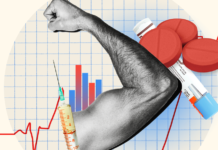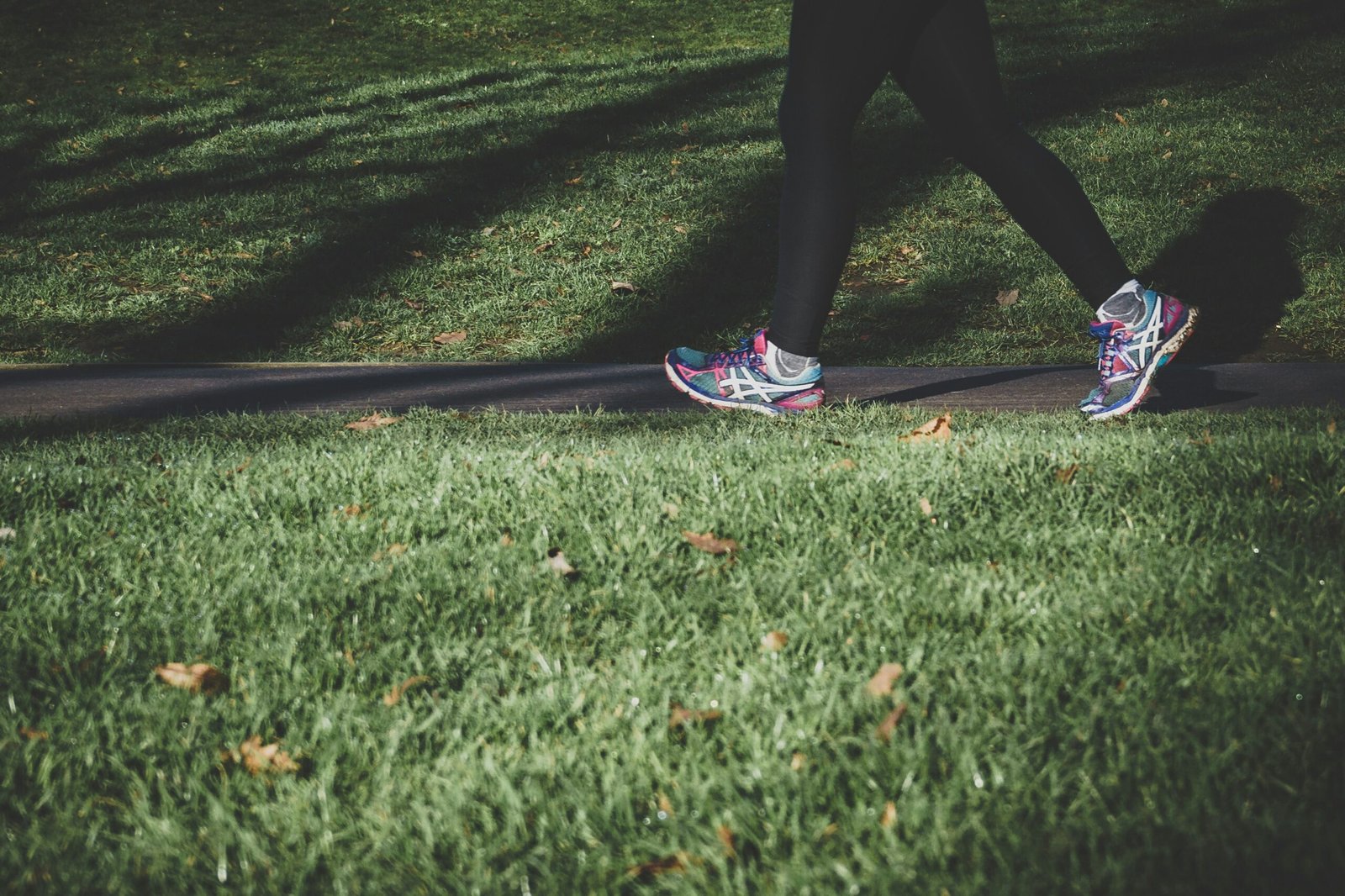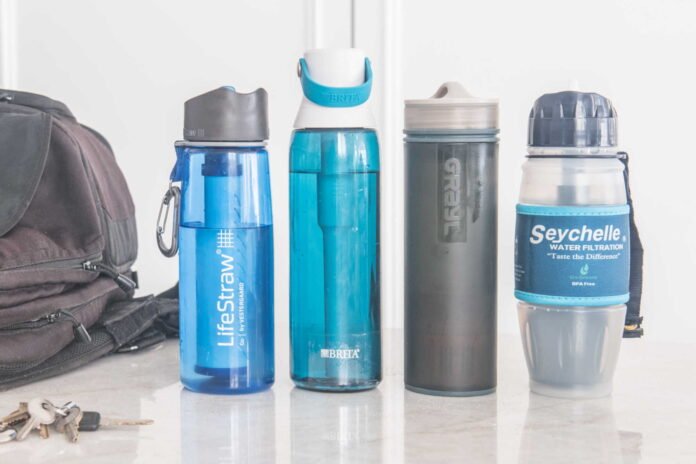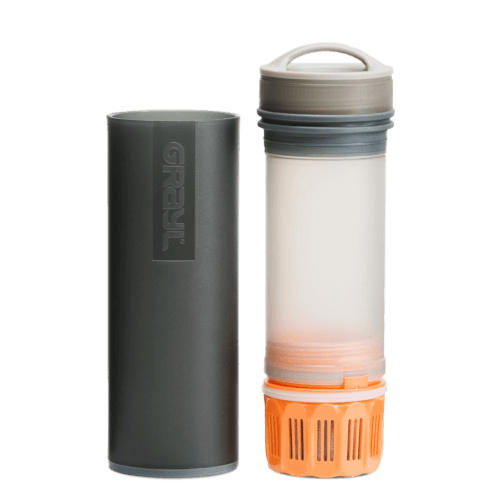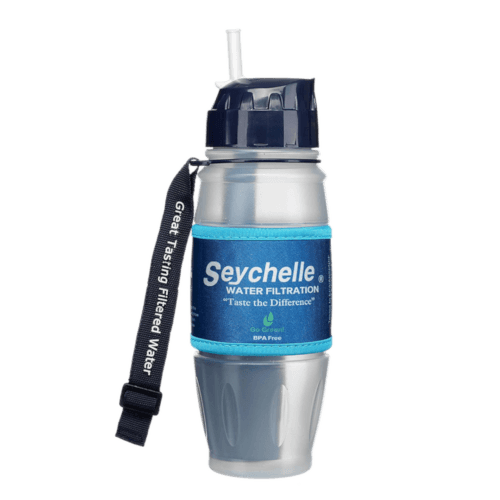The Best Filtered Water Bottles: Sip Smart and Stay Hydrated Anywhere
Staying hydrated is essential for good health, but access to clean drinking water isn’t always guaranteed. Filtered water bottles offer a convenient solution, allowing you to enjoy fresh, clean water on the go. Whether you’re hiking, traveling, or simply at work, these bottles come equipped with built-in filters that remove impurities, ensuring that every sip is safe and refreshing. In this post, we’ll explore the best filtered water bottles available, highlighting their filtration capabilities, design features, and portability. Discover the perfect bottle to keep you hydrated and healthy, no matter where life takes you!
Our Top Choices
How we selected
We’ve tested a lot of water filters over the years, including the best water filter pitchers and faucet filters. Our staff has come to appreciate the taste of chlorine-free drinking water without the added expense of buying bottled water.
We looked for systems in two different classes:
First, we looked at filters that were designed to remove only bad-tasting elements like chlorine from treated, safe-to-drink water. The standards for this type of filter are fairly easy to meet, but they’re specific. An activated carbon block or column of granules will capture most of the stuff you can smell in city water.
Second, we looked at bottles designed for use in the back country and overseas travel, where the concern is more for biological contamination than taste. We consulted guides from the Center for Disease Control and Forest Service to ensure we were checking for the right factors.
We narrowed our choices to bottles that had affordable replacement filters and were easy to purchase. A few other picks, like the Katadyn – BeFree and LifeSaver, weren’t available when we tested and weren’t competitive with the LifeStraw on pricing despite using similar technologies.
Important features to consider
Carbon filters – If you want a filter to remove the taste of chlorine and other volatile substances, activated carbon is economical and very effective. It isn’t effective at removing dissolved minerals, though, and the size of particles carbon passes through will depend on the design. Carbon filters soak up less and less contaminants the more they’re used, and they can’t be cleaned.
Ion-exchange filters – If you want to remove the dissolved salts and metals in water, ion-exchange resin will grab them. Some new tests also show that this works to capture microbial contaminants. This is one of the technologies used in Zero Water filter pitchers to get rid of all dissolved solids. Like activated carbon, the filter is used up as it cleans water, but you can’t tell how much it has left unless you count the number of times you fill the bottle.
Particle filters – If you’re mostly worried about avoiding beaver fever while backpacking, a hollow-fiber or ceramic filter can be effective at removing everything from silt to tiny virus and bacteria organisms, depending on the size of the holes. In the extra-dense microbiological filters they require hand-pump pressure or hours-long gravity filtration to make questionable water safe. These filters are fairly easy to clean and continue using for a long time, but they don’t do much to improve the taste of city water or if you use treatment drops.
Particulate ratings – NSF International and other water quality testers rate filters based on the largest compounds they can possibly let through. A smaller class number or absolute filter size will be more effective, but it will also stop working more quickly. Class I is the important class, since this means the filter stops particles larger than 0.5 microns, and that category includes some of the most worrisome organisms in mountain streams.
Effectiveness against biological contaminants – Class I particulate ratings — or better still, testing that shows compliance with the NSF Standard 53 or 58 for “cyst reduction / removal” — mean filters can trap protozoan cysts like giardia or cryptosporidium. However, these filters might still let some bacteria (which can be as small as 0.2 microns) through. The CDC highly recommends using a chlorine dioxide treatment or just boiling water before you filter it.
If you’re travelling in populated areas, virus-size organisms are a bigger concern and require an even tighter, slower filter that meets the strict P248 standard for worst-case water supplies. That kind of filter requires a high-pressure hand pump or a slow gravity-drain mechanism.
Bottles like Grayl and Seychelle claim to be effective at removing viruses with ion-exchange filters, but they don’t publish the specifications of their tests and they’re definitely not P248-rated.
Flow rating – The more quickly water flows through a filter, the easier it is to use. That’s almost always a trade-off with effectiveness, though. Also remember that if you use water that’s cloudy, the particles will plug up your filter more quickly and reduce the flow.
1
Brita – BB10: Best value for city water
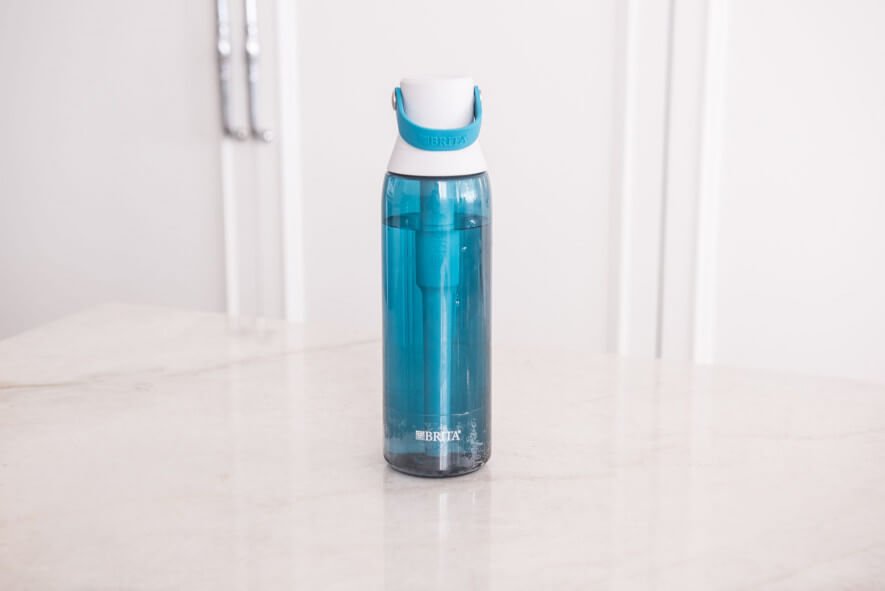
See Price at Amazon
Household water in most cities is regulated and monitored to ensure that it’s safe to drink, but treatment chemicals used often make the taste less than satisfying. The basic-yet-effective carbon filter in the Brita – BB10 Premium Filtering Water Bottle can make a big difference by removing chlorine, and that’s how Brita has built their empire of water filtration products.
This is the easiest filtered water bottle to drink from. It’s lightweight and attractive, the flip-top keeps your spout clean and the carbon filter doesn’t require as much effort to sip through compared to hollow-fiber filters that restrict water flow. Even our tester’s 1-year-old baby was able to easily drink from this bottle.Read more…
The drawback is, of course, that you can’t rely on this filter to protect you from contaminants on the trail or while travelling. With a 50-micron class VI rating, the bottle won’t catch 1-micron protozoa, let alone 0.2-micron bacteria.
But the price of the replacement filters is correspondingly low. If you replace the carbon element after 40 gallons as recommended, the cost works out to less than 10 cents per gallon filtered. That’s about the same cost as Brita’s filter pitchers, though it’s not as effective.
The Brita is a pretty good water bottle, but if you have a filter pitcher or faucet filter at home you can fill from, we think the best water bottles for buy-once durability are stainless steel.
 Pros
Pros
- A great bottle design with flip-up straw cover
- Removes most chlorine for better taste
- Affordable filters
 Cons
Cons
- Won’t make contaminated water safe
- Not as durable as a stainless steel bottle.
2
Grayl – Ultralight: Best for travel
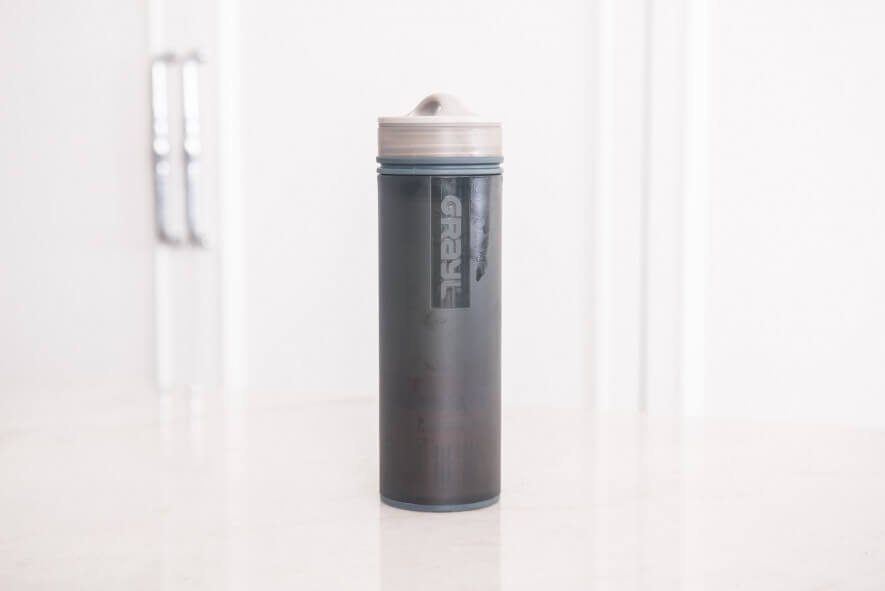
See Price at Amazon
If you’re looking for a purifying water bottle that’s effective against more than just chlorine, the unique Grayl – Ultralight bottle uses a three-stage filter, including an ion-exchange stage that will capture everything from metals to microbes.
Grayl’s system requires more pressure to allow the use of a more restrictive filter, so they designed the bottle to work like a French press. Untreated water goes in the outer container, and pressing a filter down (which takes about 15 seconds and quite a bit of effort) gives you an inner bottle with 16 ounces of clean water.Read more…
This filter method allows you to distribute water to multiple people on a group hike or to (very slowly) fill up a campsite storage container. It’s better-suited to making camp coffee with an Aeropress than it is to supplying an entire camp kitchen, but the fact that you don’t need to use a straw makes this the most versatile bottle.
We reached out to Grayl about testing standards, and co-founder Travis Merrigan responded with all the documentation. Grayl doesn’t meet the US military P248 standard for worst-case-scenario water, but it did pass a test based on the P231 protocol that’s a benchmark for capturing bacteria and virus organisms. Capturing chlorine as well as inorganic minerals like mercury and fluoride is a nice bonus over traditional backpacking filters.
The big downside with ion-exchange filters is always how short-lived they are, and that there’s no clear sign they’ve stopped capturing things. Grayl has designed these filters to plug up with sediment long before the ion-exchange resin is depleted, but you should still be prompt about replacing filters after 300 uses.
 Pros
Pros
- Excellent filter performance that’s easy to use on the go
- Easy to fill and compact (no hose!)
- Filters dissolved chlorine and metals as well as pathogens
 Cons
Cons
- Not tested to the same standards as military-grade pump-style filters
- Filters have limited life, replacement is expensive
- Not big enough to be a primary backpacking bottle
3
Seychelle – Extreme: Best taste
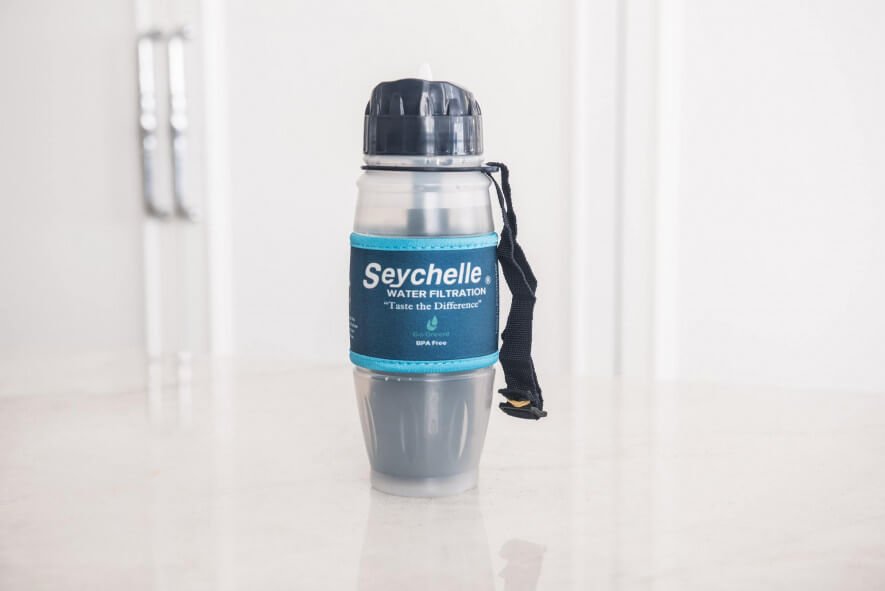
See Price at Amazon
If you’re looking for better performance than the Brita, but you don’t need the flexibility of the Grayl’s batch filter design, the Seychelle – Extreme filters water as you drink it.
The Seychelle is a tough, squeezable bottle that lets you add a little bit of pressure to the unfiltered water to make sipping easier. It’s also more resistant to cracking than the rigid plastic on the other bottles if you drop it.Read more…
The Extreme bottle comes with a “RAD/ADV” filter, which uses carbon for chlorine and taste, plus ion exchange (like Grayl) to capture microbiological nasties and metals. Seychelle hasn’t published a registered NSF International P248 test, and the tests they do post don’t even specifically show biological contaminant testing. But the principle is sound, and in our less-formal taste testing it’s the best at improving the flavor of water.
Because this filter uses an ion-exchange resin to capture the worst contaminants, the big expense comes from replacing the filter after every 100 gallons or so. There’s no precise indication of how much life the filter has left, and unlike the Grayl it won’t plug up when it’s near end-of-life.
Even if you’re using chloride drops to kill virus and bacteria organisms, this filter system will prevent chlorine-resistant protozoa from slipping through and dramatically improve the taste. It’s probably not worth the price for filtering chlorine out of tap water, but for about 25 cents per gallon it’s definitely cheaper than buying bottled water.
 Pros
Pros
- Multi-stage filtration removes more contaminants than Brita or LifeStraw
- Flexible, rugged bottle
- Straw filter doesn’t require stopping to press like Grayl
 Cons
Cons
- Filters are middle of the pack for value
- You’ll need to track filter life if you’re relying on this bottle to purify
- No hard proof of virus elimination claims
4
LifeStraw – Go
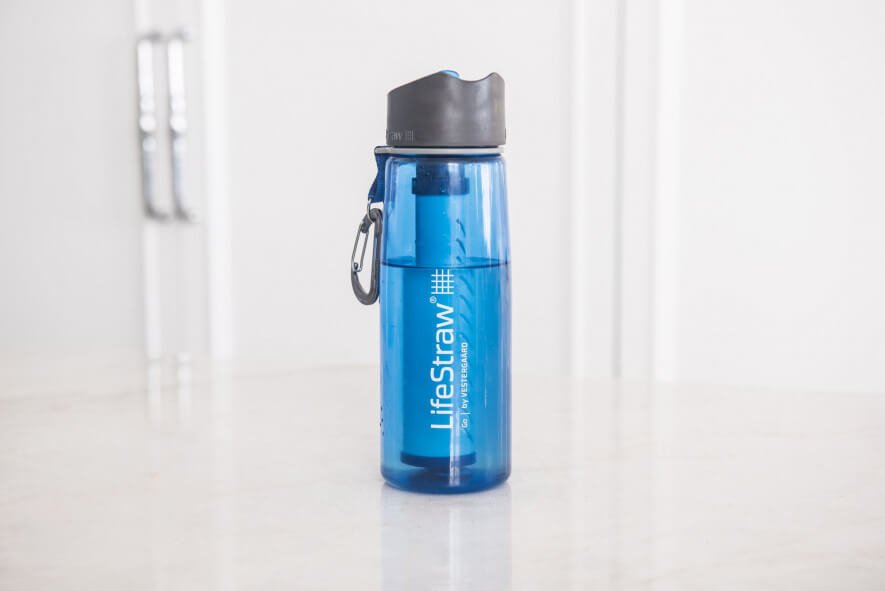
See Price at Amazon
Like the other outdoor-oriented bottles we tested, the LifeStraw – Go uses multiple stages of filtration to capture the things you don’t want to drink. The LifeStraw is unique in that it lets you replace the short-lived carbon element and the washable fiber filter separately, which means that you get more bang for your buck.
If you already have a bottle you love, like the Klean Kanteen we picked in our water bottle review, you can buy LifeStraw technology as a universal lid for the best-known water bottles.Read more…
LifeStraw is the only bottle manufacturer that provides extensive documentation of test results. P248 compliance is on the books for their first-stage filter membrane, and tests show it will capture smaller organisms down to 0.14 microns. That said, LifeStraw themselves recommend the pressurized or gravity-driven Mission system if you’re worried about viral contamination.
The second stage of the Lifestraw – Go is a tiny carbon filter. It’s not helping filter any of the biological or industrial contaminants, so keeping it a small and affordable part of the system is reasonable. But it is the most important element for improving taste.
We were satisfied with the amount of chlorine that the LifeStraw can remove, but if you use treatment drops to eliminate virus risks, then this definitely comes in last place for taste. It’s also just as expensive per-gallon to keep replacing these filters as the Grayl’s fancy ion-exchange system, according to the recommended schedule. If you only use the LifeStraw in crystal-clear water and the membrane never gets plugged up, you’ll save about 25 cents per gallon over the Grayl. If you use it to drink out of murky puddles, you’ll wind up replacing it more often than that even if you can wash the filter.
 Pros
Pros
- Tested to more exact standards than other bottle filters
- Washable filter element does the heavy lifting
- Also available as a universal lid for other popular water bottles
 Cons
Cons
- Last place for taste improvement
- Once the filter begins to load up, it’s difficult to drink through
- Carbon filter element is expensive given the size

